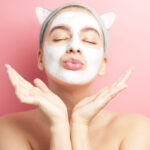Skin lightening is a cosmetic practice that has gained widespread popularity in recent times. It involves using products or procedures to reduce the concentration of melanin in the skin, leading to a lighter complexion. Skin lightening is often pursued for a variety of reasons, including cosmetic, cultural, or medical purposes. In this article, we will explore the various methods used for skin lightening.
One of the most common methods of skin lightening is the use of topical creams or lotions. These products typically contain ingredients such as hydroquinone, kojic acid, or arbutin, which work by inhibiting the production of melanin in the skin. These creams and lotions are often available over-the-counter or through prescription, and can be applied directly to the skin on a regular basis.
Another popular method of skin lightening is chemical peels. Chemical peels involve the application of a chemical solution to the skin, which causes the outermost layer of skin to peel away. This process can help to reduce the appearance of dark spots and uneven pigmentation, leading to a brighter and more even complexion. Chemical peels can be performed in a dermatologist’s office or at home using over-the-counter products.
Microdermabrasion is another option for skin lightening. This procedure involves using a device to remove the outermost layer of skin, which can help to reduce the appearance of dark spots and hyperpigmentation. Microdermabrasion is typically performed in a dermatologist’s office and can require multiple sessions to achieve optimal results.
Laser therapy is another method used for skin lightening. This procedure involves using a laser to target areas of hyperpigmentation, which causes the melanin to break down and be absorbed by the body. Laser therapy can be effective in reducing the appearance of dark spots and uneven pigmentation, but can be expensive and may require multiple sessions.
Laser therapy is one of the most effective methods used for skin lightening. This procedure involves the use of a laser to target areas of hyperpigmentation in the skin. The laser works by breaking down the melanin in the skin, which is then absorbed by the body. Laser therapy can be an excellent option for individuals who are looking to reduce the appearance of dark spots, age spots, and other forms of hyperpigmentation.
The procedure itself typically takes between 30 minutes to an hour and can be performed in a dermatologist’s office. During the procedure, the skin is numbed with a local anesthetic, and the laser is applied to the targeted areas. Patients may experience some discomfort during the procedure, but this can be managed with pain medication or a cooling gel.
In addition to these methods, there are also natural remedies that can be used for skin lightening. These remedies typically involve using ingredients found in nature, such as lemon juice, turmeric, or aloe vera. While these remedies may be effective in reducing the appearance of dark spots and hyperpigmentation, they may not be as potent as other methods and can take longer to achieve results.
It is important to note that skin lightening is not without its risks. Some of the common side effects of skin-lightening products and procedures include skin irritation, inflammation, and hypersensitivity to sunlight. In addition, some skin-lightening products have been linked to more serious health issues, such as skin cancer and liver damage. It is important to consult with a dermatologist before pursuing any method of skin lightening to ensure that it is safe and appropriate for your individual needs.
In conclusion, skin lightening is a cosmetic practice that can be achieved through a variety of methods, including topical creams, chemical peels, microdermabrasion, laser therapy, and natural remedies. While these methods can be effective in reducing the appearance of dark spots and hyperpigmentation, they are not without their risks and should be approached with caution. It is important to consult with a dermatologist before pursuing any method of skin lightening to ensure that it is safe and appropriate for your individual needs. By taking the proper precautions and working with a qualified professional, you can achieve a brighter and more even complexion.








